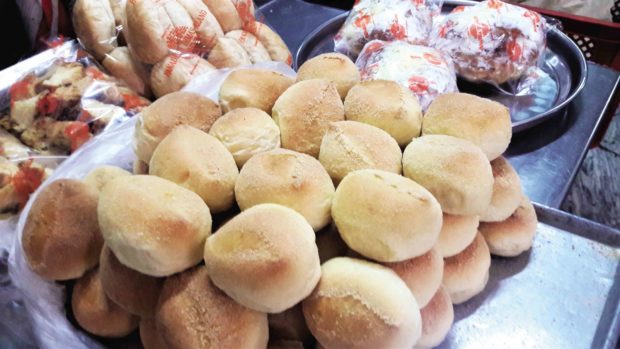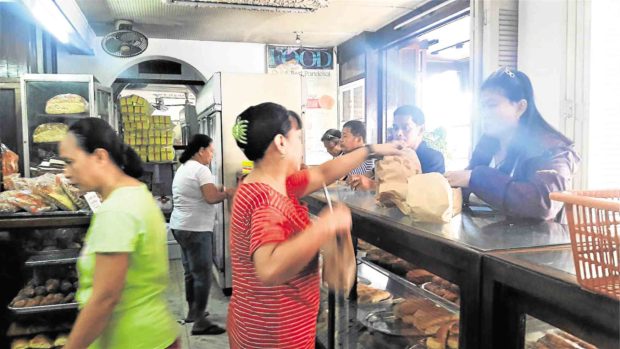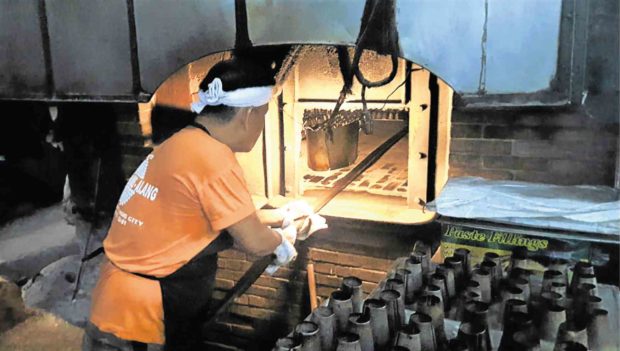Our daily (shrinking) bread
At the crack of dawn, the familiar aroma of baking “pan de sal” wafts out of the wood-fired oven of Dimas-Alang Bakery on Mabini Street, Pasig City.
It is a smell that generations of Pasigueños and loyal patrons from out of town have grown up with, one so strongly identified with the good times and that warm, homey feeling shared with the family.
But alas, the crusty, crumb-dusted pan de sal that has become a staple in Pinoy culture has itself become a casualty of the times.
While the 99-year-old Dimas-Alang Bakery continues to serve the iconic breakfast staple, the high inflation rate has shrunk its size, what with the rising price of ingredients and other production costs.
Dough and profits
Article continues after this advertisement“We used to have a mantra, which says: Once the dough has risen, so does your profit—by about half the price of the pan de sal. Sadly, it’s no longer true,” said the bakery owner, Manolo Lozada.
Article continues after this advertisementRegular pan de sal has been sold for P2 apiece for the last decade, Lozada said.
But with the surging price of ingredients and other costs, bakery owners have been forced to shrink the size of the pan de sal to maintain its price and protect profit margins.
Slightly bigger pan de sal — what used to be its regular size —costs P3 each in most bakeries, including Dimas-Alang.
Consumers, too, have scaled back on their demand. Master baker Dominador Caguioa, 52, has seen the business prosper and slump through the years, but noted that sales were no longer as brisk as they were in the 1980s and ’90s.

SIZE MATTERS Today’s regular “pan de sal” (left) sells for P2 a piece, but its bigger versions sold for P1 in the 1990s and 1980s, respectively.
Better days
During those times, Caguioa recalled, the bakery would use up to 20 bags of flour a day to bake thousands of pan de sal that would usually be sold out in the morning. Nowadays, the bakers open only five bags of flour a day to produce around 1,500 pieces.
“The sales were better in the ’80s and ’90s because people were really getting more than their money’s worth,” Caguioa said. “During the rainy season, we’d sell more than usual because pan de sal has always been seen as a readily available staple at any time of the day.”
The pan de sal—a pillowy roll made of flour, eggs, yeast, sugar, and salt—first became a hot seller in the 1980s, literally sold hot as they often come straight from the oven and into brown paper bags. Old-timers trace the beginnings of this pastry phenomenon to enterprising Filipinos who, making do with cramped work areas at home or rented commercial spaces, installed giant ovens that operated 24/7.
Adding to its cultural flavor, the process of making pan de sal has never lost its traditional tools, most notably the wooden cutter—preferably narra—used to create the almond-shaped ridge (known as “singkit” or “gatla”) on the top of each bread.
Like baking supplies, such as flour and sugar whose prices have increased by as much as 20 percent, these wooden implements have become expensive, too, Lozada said.
For one, he said, the wood used at Dimas-Alang has to be sourced from Laguna province to meet certain standards. And they do not come as cheap as the metal tools, he added.
Even the custom-made metal trays for the bread have also become more expensive, from the previous P12 per piece to at least P60.

MORNING RITUAL Early risers in Pasig get their breakfast staple at their neighborhood bakery, the 99-year-old Dimas-Alang.
10 p.m. crowds
Despite these, Lozada said the bakery would keep churning out pan de sal as long as there was demand for it.
And judging from the crowd that forms in front of the bakery’s glass cabinets, there’s reason to keep the ovens hot.
Customers hoping to get the freshest batch of pan de sal start showing up, remarkably, at night—around 10 p.m. The store gets busiest serving breakfast buyers from 6 to 7 in the morning.
Three pan de sal variants are on offer—regular, large and “egg”—but most customers prefer regular, which sells at P2 each. Lozada sadly notes that these days, longtime customers who used to buy 15 to 20 pieces now settle for only 10.
Still, Caguioa, the master baker, believes that the lowly pan de sal will never lose its filling, comforting taste as a Filipino favorite, come hell or high inflation.
